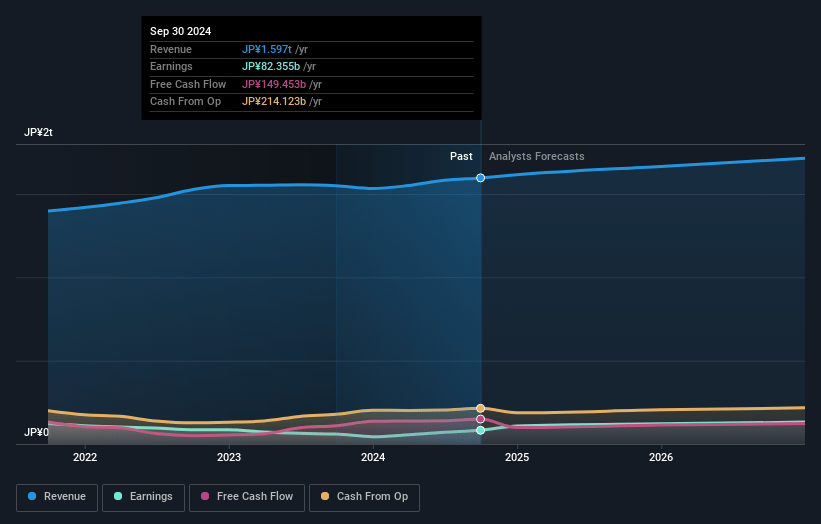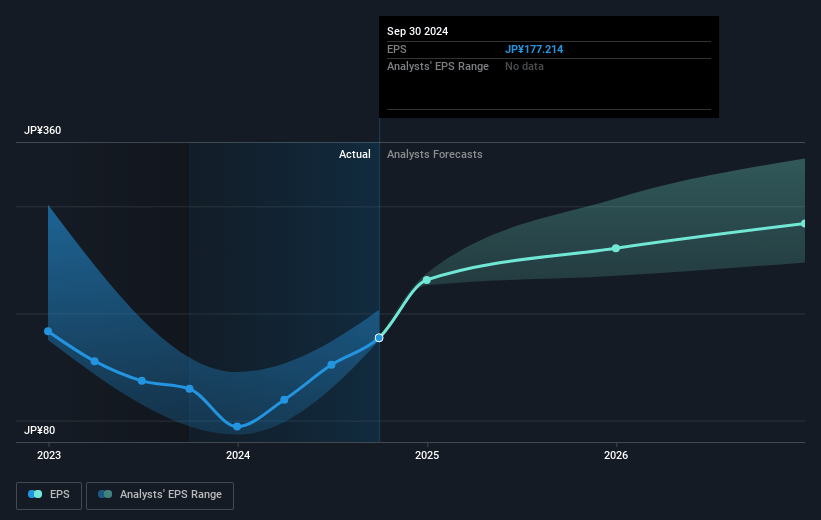Key Takeaways
- Enhancing product value and brand loyalty and expanding cosmetics in China drives growth in revenue and operating margins.
- Cost reductions and digital strategies improve competitiveness, operational efficiency, and profitability with a focus on high-value products.
- Vulnerability to geopolitical and market changes, especially in Asia and rising costs, could pressure revenue growth and margins, complicating profit sustainability.
Catalysts
About Kao- Develops and sells hygiene and living care, health and beauty care, life care, cosmetics, and chemical products.
- Kao's promotion of higher added value products and strengthening brand loyalty are expected to drive future revenue growth, particularly in the Consumer Products and Chemical businesses. This is anticipated to positively impact revenues and operating margins.
- Efforts in structural reforms, such as cost reductions while maintaining quality, are set to improve Kao's competitiveness and profitability. This will likely lead to enhanced net margins and earnings.
- Expansion in the Cosmetics business, particularly due to improvements and market recovery in China, is projected to contribute to profit growth, enhancing net income and earnings per share.
- The start-up of new facilities, such as the tertiary amine facility in the U.S., and improvements in product mix with a higher ratio of high-value-added products are expected to enhance gross margins and operating income in the Chemical business.
- Kao's deployment of digital marketing and data-driven management, coupled with initiatives in co-creation with partners, is expected to boost operational efficiency, leading to improvements in revenue growth and return on invested capital (ROIC).
Kao Future Earnings and Revenue Growth
Assumptions
How have these above catalysts been quantified?- Analysts are assuming Kao's revenue will grow by 3.1% annually over the next 3 years.
- Analysts assume that profit margins will increase from 6.6% today to 8.0% in 3 years time.
- Analysts expect earnings to reach ¥142.9 billion (and earnings per share of ¥308.88) by about April 2028, up from ¥107.8 billion today. However, there is some disagreement amongst the analysts with the more bullish ones expecting earnings as high as ¥164.8 billion.
- In order for the above numbers to justify the analysts price target, the company would need to trade at a PE ratio of 27.6x on those 2028 earnings, up from 26.0x today. This future PE is greater than the current PE for the JP Personal Products industry at 25.8x.
- Analysts expect the number of shares outstanding to decline by 0.08% per year for the next 3 years.
- To value all of this in today's terms, we will use a discount rate of 5.53%, as per the Simply Wall St company report.
Kao Future Earnings Per Share Growth
Risks
What could happen that would invalidate this narrative?- A significant decrease in sales in Asia by 9.7%, particularly in the Chinese Cosmetics market, indicates ongoing challenges that could affect revenue growth and profitability in that region.
- An increase in SG&A expenses by ¥19 billion, driven by marketing and rising labor costs, may put pressure on net margins and earnings if not offset by corresponding revenue growth.
- Expected rise in raw material costs, such as fats, oils, and packaging linked to inflation, could impact cost structures and gross margins, particularly if price increases do not fully absorb the increased costs.
- High dependence on structural reforms for profit growth suggests that sustaining current levels of growth may be challenging once the effects of these reforms begin to level off, potentially impacting future earnings and net margins.
- Vulnerability to geopolitical and market changes, such as potential further deterioration in the Chinese market or global economic shifts, could pose risks to revenue stability and profit achievement targets like the K27 goals.
Valuation
How have all the factors above been brought together to estimate a fair value?- The analysts have a consensus price target of ¥7233.333 for Kao based on their expectations of its future earnings growth, profit margins and other risk factors. However, there is a degree of disagreement amongst analysts, with the most bullish reporting a price target of ¥8900.0, and the most bearish reporting a price target of just ¥6700.0.
- In order for you to agree with the analyst's consensus, you'd need to believe that by 2028, revenues will be ¥1783.5 billion, earnings will come to ¥142.9 billion, and it would be trading on a PE ratio of 27.6x, assuming you use a discount rate of 5.5%.
- Given the current share price of ¥6023.0, the analyst price target of ¥7233.33 is 16.7% higher.
- We always encourage you to reach your own conclusions though. So sense check these analyst numbers against your own assumptions and expectations based on your understanding of the business and what you believe is probable.
How well do narratives help inform your perspective?
Disclaimer
Warren A.I. is a tool utilizing a Large Language Model (LLM) that ingests data on consensus price targets, forecasted revenue and earnings figures, as well as the transcripts of earnings calls to produce qualitative analysis. The narratives produced by Warren A.I. are general in nature and are based solely on analyst data and publicly-available material published by the respective companies. These scenarios are not indicative of the company's future performance and are exploratory in nature. Simply Wall St has no position in the company(s) mentioned. Simply Wall St may provide the securities issuer or related entities with website advertising services for a fee, on an arm's length basis. These relationships have no impact on the way we conduct our business, the content we host, or how our content is served to users. The price targets and estimates used are consensus data, and do not constitute a recommendation to buy or sell any stock, and they do not take account of your objectives, or your financial situation. Note that Warren A.I.'s analysis may not factor in the latest price-sensitive company announcements or qualitative material.




